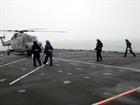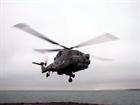Defender experiences the Lynx effect during first helicopter trials
New destroyer HMS Defender hosted a helicopter for the first time as a Lynx touched down on her sweeping flight deck. The Portsmouth-based Type 45 is conducting her first period of trials and training under the White Ensign off the South Coast.
HMS Defender’s handlers stride across the expansive flight deck – very ably demonstrated here – to tie down a Lynx Mk8 as the new destroyer operates a helicopter for the first time. 815 Naval Air Squadron in Yeovilton supplied the whirlybird – as they do for all Type 45s, the lone Type 42 destroyer still active (HMS Edinburgh, deployed right now to the South Atlantic), some Type 23 frigates and whichever warship or RFA requires a Flight in support of their missions around the globe.
Any landing at sea, irrespective of the size of the flight deck, is a challenging affair for the aircrew.
But the Lynx trials aboard D36 – the fifth of six Type 45s to be handed over to the Royal Navy – were principally aimed at testing the ship and her sailors to support a Flight, providing everything needed to launch, recover (ie land), refuel and look after a helicopter in challenging conditions at sea - tests which, we’re told, were all passed with flying colours.
“Preparing for an aircraft to land onto a warship is a task which involves everyone aboard,” explained Sub Lt Dan Drew, Defender’s deputy logistics officer. “From the obvious things like planning and executing these operations, to the less obvious such as painstakingly checking the upper deck for debris which could be harmful to the helicopter, everyone plays a part in increasing Defender’s capabilities that little bit further.”
During the day-long trial, all departments of the ship’s company took the opportunity to broaden their training horizons by working with the Flight. Crash boat crews discussed how to rescue the fliers should the Lynx be forced to ditch, the ship’s medical teams looked at how casualties could be evacuated by helicopter and even the stokers got in on the act, practising the delivery of aviation fuel.
Defender sailed for the first time under the White Ensign at the end of September, setting off down the long road to front-line duties by carrying out the basics of operating a warship at sea. So as well as the helicopter trials, among other evolutions the ship has been practising is rescuing Fred – a large, heavy orange dummy who’s as bumbling as Mr Bean. If there’s a disaster to be had, Fred’ll be there. Probably causing it. Like falling into the Channel. Time to deploy the ‘swimmer of the watch’ – an on-call member of the ship’s company who drops everything and dons rescue suit if there’s a (wo)man overboard. While Defender’s Pacific 24 boats are the main means of rescue, there is always a swimmer on standby, just in case. In this instance Defender’s first ever ‘swimmer of the watch’ was AB(Sea) Laura McBarron, who jumped into the ocean after Fred.
“It is a bit of a daunting task to be sent over the side of an 8,000-tonne warship, but the training we receive is first-class and really prepares you for it,” she said. “I was a little bit nervous before I did it, but it was fun and I wouldn’t think twice about doing it again – unless it was the middle of winter!”
Defender’s due back in Portsmouth after this initial training period tomorrow.





